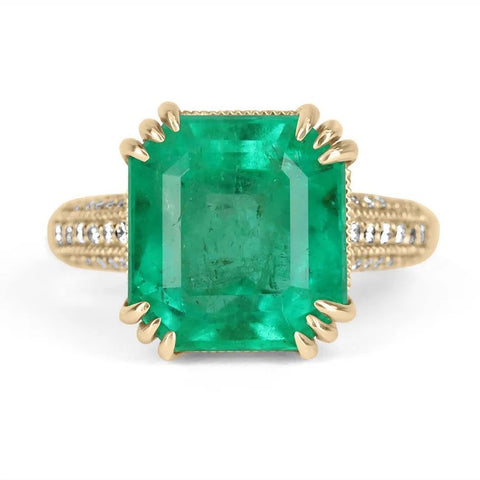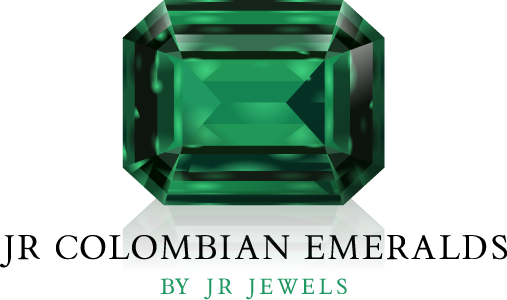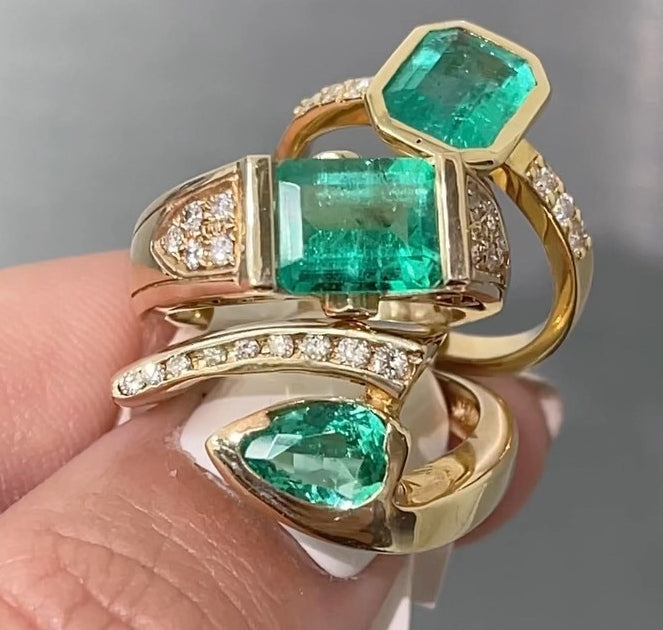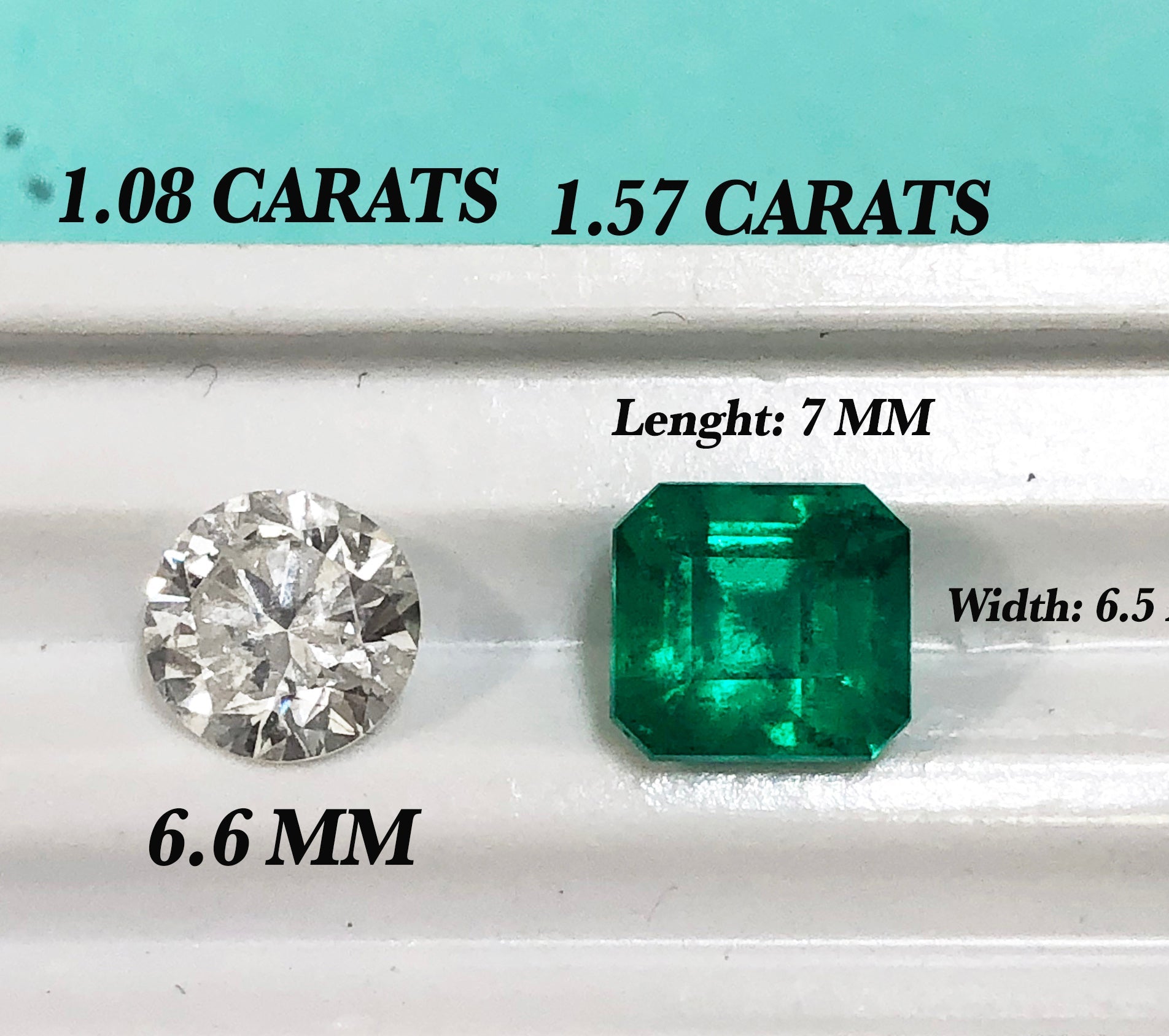Emeralds are not just any gemstone; they are a testament to nature's beauty and awe-inspiring power. There's something undeniably captivating about their mesmerizing green color and the way they shimmer in the light. It's no wonder that emeralds have been prized for centuries and treasured by royalty and celebrities alike.
As you hold an emerald in your hand, you can't help but feel a sense of wonder and amazement at the stone's exquisite beauty. It's like you're holding a piece of nature's art that has taken millions of years to create. But what makes emeralds so special, and how can you tell if you're getting a high-quality stone?
 In this guide, we'll cover everything you need to know about emeralds, from their history and symbolism to their grading and certification. So, whether you're looking to invest in an emerald or simply appreciate its beauty, this guide is an essential resource for anyone who loves these precious gems.
In this guide, we'll cover everything you need to know about emeralds, from their history and symbolism to their grading and certification. So, whether you're looking to invest in an emerald or simply appreciate its beauty, this guide is an essential resource for anyone who loves these precious gems.

History of Emerald Stones and Their Uses
Egyptian Times - 3100 BCE to 30 BCE
Ancient Egypt is considered one of the earliest civilizations in human history and spanned over 3,000 years, from around 3100 BCE to 30 BCE. During this time, emeralds were highly valued and used in various forms of jewelry, including necklaces, bracelets, rings, and earrings.
The Ancient Egyptians believed that emeralds represented fertility and rebirth, and they often buried their dead with emeralds to ensure a successful afterlife. The gemstone was also associated with the goddess Isis, who was the mother goddess and the symbol of motherhood, fertility, and rebirth.
Emeralds were also considered a symbol of eternal youth, and Egyptian nobility would often wear emerald jewelry to symbolize their wealth and power. The most famous ancient Egyptian figure associated with emeralds is Cleopatra, who was known to have a passion for emeralds and would adorn herself with these precious stones.
The Ancient Egyptians also believed that emeralds had healing properties and were used in medicine. The gemstone was believed to help with eye problems and was also used as a general tonic to improve overall health.
Emeralds were highly valued in Ancient Egypt and used in various forms of jewelry, medicine, and religious artifacts. They were associated with fertility, rebirth, and eternal youth and were often worn by Egyptian nobility as a symbol of their wealth and power.

An ancient Roman emerald, pearl, and gold ring.
Greek Era ~ 800 BCE to 146 BCE
The Greek civilization flourished from approximately 800 BCE to 146 BCE. It is often referred to as the "Classical" era because of its significant contributions to art, philosophy, and literature. The Greeks highly valued emeralds and believed they had healing properties. The philosopher Aristotle wrote about the beauty and virtues of emeralds, and they were often used in Greek jewelry. Greeks believed that wearing emeralds close to the skin could help cure diseases, soothe the eyes, and relieve stress.
The Roman ~ 753 BCE to 476 CE
The Roman civilization flourished from approximately 753 BCE to 476 CE. The Romans were great admirers of emeralds and used them extensively in jewelry. They believed that emeralds had the power to soothe the eyes and restore eyesight. Roman author Pliny the Elder wrote about emeralds in his famous work "Natural History," describing them as the "most precious of stones." The Romans also believed that emeralds could help with fertility and were often worn as amulets by women hoping to conceive.
During the Roman era, emeralds were highly prized for their beauty, and they were often incorporated into intricate pieces of jewelry. The Roman empire was vast, and emeralds were traded throughout its territories. Some of the most famous emerald jewelry from this era were the emerald earrings of the Byzantine Empress Theodora, which were said to have been adorned with large, pear-shaped emeralds. The Roman empire's collapse marked the end of this era, but the influence of Greek and Roman art and culture has lasted throughout history.

Incas Jewelry
The Incas ~ 1438 CE to 1532 CE
The Inca Empire was the largest pre-Columbian civilization in the Americas and flourished in the Andes Mountains of South America from the 15th century until the arrival of the Spanish conquistadors in the 16th century. The Incas had a deep appreciation for emeralds, which they believed had mystical powers and could bring good luck and prosperity to those who possessed them.
The Incas referred to emeralds as "Yacumama," which means "Mother of All Waters." They believed that emeralds were a gift from their gods and had the power to protect their crops from drought and pests. The Incas used emeralds in their jewelry, clothing, and religious artifacts. They also used emeralds to decorate their temples and palaces, including the famous Temple of the Sun in Cusco.
The Incas obtained emeralds through trade with other civilizations, including the Muisca people of modern-day Colombia. The Muisca were known for their expertise in emerald mining and used emeralds in their religious ceremonies. The Incas valued emeralds so highly that they were sometimes used as currency in their trade with other civilizations.
The Inca Empire was conquered by the Spanish in the 16th century, and many of the Incas' treasures, including their emerald jewelry and artifacts, were looted or destroyed. However, some of the Inca's finest emerald pieces survived, including the famous Inca Emerald, a 24-carat emerald that was part of the Inca's religious artifacts and is now housed in the Museum of Natural History in New York City.
In conclusion, the Incas had a deep appreciation for emeralds, which they believed had mystical powers and could bring good luck and prosperity. They used emeralds extensively in their jewelry, clothing, and religious artifacts, and they were highly prized in their trade with other civilizations. Despite the destruction wrought by the Spanish conquest, the Incas' legacy in emerald jewelry lives on.

The picture displayed above shows a pendant made of gold and emerald that is believed to have been created between 1680 and 1700 CE. The photograph was taken at the Victoria and Albert Museum.
Emeralds in the Middle Ages and Today
Middle Ages 15-18th Century


During the Spanish conquest, they embarked on voyages of discovery to explore and claim new territories. They discovered the Americas, which they quickly colonized and exploited for their natural resources, including gold, silver, and precious gemstones like emeralds in Colombia.
The Spanish Golden Age, which lasted from the late 16th century to the early 17th century, was a period of great cultural, artistic, and economic achievement in Spain. The country became a major power in Europe, and Spanish explorers continued to venture into new territories in search of riches.
The Bourbon Reforms, which began in the 18th century, were a series of political and economic reforms aimed at modernizing Spain's institutions and strengthening its economy. These reforms had a significant impact on Spain's colonies, including those in South America where emeralds were discovered.
During this era, emeralds were highly prized by the Spanish and became an important commodity in international trade. The Spanish acquired vast quantities of emeralds from their colonies in South America, and these gemstones were used to create exquisite pieces of jewelry for the Spanish royal court and the European nobility.
Overall, the Spanish era was a time of great exploration, discovery, and economic growth, during which Spain played a dominant role in the global economy and acquired great wealth and power. The discovery and exploitation of emeralds were just one of the many ways in which Spain became a major player on the world stage during this period.
 |
 |
(Left Picture) The Taj Mahal emerald was once part of a collection of jewels owned by the Mughal emperor Shah Jahan, and was later gifted to his wife Mumtaz Mahal, whose tomb is the iconic Taj Mahal monument in Agra, India.
(Right Picture) Mughal era gold horn pendant with 125 ct. Colombian emerald, diamonds, Burmese rubies, emerald beads, and pearls (photo by Robert Weldon/GIA)
The Mughal Empire was a powerful and influential empire that ruled over the Indian subcontinent from 1526 to 1857. During their reign, the Mughals developed a deep appreciation for fine arts, including jewelry making, and emeralds were one of the gemstones they valued most highly.
The Mughals believed that emeralds had special properties that made them powerful symbols of wealth, status, and protection. They were often used in royal regalia, and the Mughal rulers were known to have owned some of the most impressive emeralds in the world.
One of the most famous emerald artifacts from the Mughal era is the Mughal Emerald, a large emerald inscribed with prayers and dates that was owned by the Mughal emperor Aurangzeb. The Mughal Emerald weighed over 200 carats and was considered to be one of the most valuable emeralds in the world.
During the Mughal era, emeralds were often cut in a rectangular shape with flat facets, which was known as the "Mughal cut." This cut emphasized the gemstone's color and clarity and allowed it to shine in the light. The Mughal cut is still used today in modern emerald jewelry.
The Mughal era was a time of great artistic and cultural achievement, and the jewelry produced during this period is considered some of the most beautiful and valuable in the world. The Mughal's love of emeralds continues to inspire jewelers and jewelry enthusiasts to this day.
 |

|
Art Deco ~ 1920 CE to 1940 CE
The Art Deco era, which spanned from the 1920s to the mid-1930s, was a time of great innovation and creativity in the world of jewelry design. The movement originated in Paris and quickly spread throughout Europe and the United States, influencing everything from architecture to fashion.
Art Deco jewelry is characterized by bold geometric shapes, contrasting colors, and the use of new materials such as platinum and synthetic gemstones. The style is often described as sleek, modern, and glamorous, with an emphasis on symmetry and precision.
Emeralds were a popular gemstone during the Art Deco era and were often paired with diamonds, sapphires, and other precious stones to create striking contrasts. Emeralds were frequently cut in the rectangular or square shape known as the "emerald cut," which complemented the geometric style of Art Deco jewelry.
Designers of Art Deco jewelry were often inspired by the exoticism of non-Western cultures, particularly Egyptian and Oriental motifs. This led to the use of motifs such as lotus flowers, scarabs, and stylized animals in Art Deco jewelry.
Some famous examples of Art Deco emerald jewelry include the necklace worn by Greta Garbo in the film "Camille" and the emerald and diamond tiara worn by the Duchess of Windsor. Today, Art Deco jewelry remains highly prized by collectors and is regarded as a high point in the history of jewelry design.
 |

|
Modern Times
The Modern times era, which covers the period from the mid-20th century to the present day, has seen a wide range of styles and trends in emerald jewelry. One of the most significant developments in modern times has been the increasing popularity of emeralds in engagement rings. This trend began in the 20th century, when many couples started to opt for non-traditional gemstones in their engagement rings. Emeralds, with their striking green color and symbolism of love and loyalty, became a popular choice for engagement rings. Celebrities, such as Angelina Jolie and Halle Berry, have been seen wearing emerald jewelry on the red carpet.
Overall, the Modern times era has seen a diverse and dynamic range of styles and trends in emerald jewelry. Whether it is a classic and timeless piece or a bold and innovative design, emerald jewelry continues to capture the imagination and fascination of people around the world.
Different Types of Emeralds
There are several different types of emeralds, each with its unique characteristics and properties. Below are a few of the most common types:
Colombian Emeralds: These are the most sought-after and prized emeralds in the world. Colombian emeralds are known for their vivid green color and are often more free of any inclusions or fissures. Click here to buy the best quality Colombian Emeralds.
Brazilian Emeralds: These emeralds tend to be a lighter green color and often have more inclusions than Colombian emeralds. However, they can still be beautiful and valuable.
Zambian Emeralds: Zambian emeralds are known for their deep green color and can have a more bluish tint. They often have heavier inclusions but can be treated to enhance their color and clarity.
Synthetic Emeralds: These are lab-created emeralds that have the same chemical composition as natural emeralds but are made in a controlled environment. They can be a more affordable option however do not have rarity or value as natural emeralds.
Treated Emeralds: Approximately 98% of natural emeralds are treated to enhance their clarity and other factors. These treatments can include oiling, resin filling, or dyeing.
Overall, there are many different types of emeralds, each with its unique qualities and characteristics. When buying an emerald, it's essential to consider its type, origin, and any treatments it may have undergone to determine its value and desirability.
Mystery Behind the Beauty of Emeralds

The Different Beryl Varieties with Photos
Emeralds are a variety of mineral beryl, and they get their green color from trace amounts of chromium and/or vanadium. Unlike many other gemstones, emeralds often have inclusions and fissures, which are natural imperfections within the stone. These inclusions can create unique patterns and contribute to the stone's overall character and beauty.
Due to their natural inclusions, emeralds are typically treated with oiled tp enhance their clarity. This treatment can improve the stone's appearance, but it's important to note that not all emeralds are treated in the same way. Some emeralds are untreated, while others may have been treated with a less desirable method.
Natural Properties and Characteristics
When selecting an emerald, it's important to consider the stone's natural properties and characteristics. The color, clarity, and cut of the stone are all essential factors to consider, as well as the origin of the stone and any treatment it may have undergone. Despite their imperfections, emeralds are a beloved gemstone, cherished for their unique beauty and rarity. Their natural inclusions and fissures only add to their character and make each stone a one-of-a-kind treasure.

What is Inclusions in Emeralds
Inclusions are natural characteristics within emeralds that can be seen under magnification or with the naked eye. These inclusions can be cracks, fissures, bubbles, or other mineral crystals that formed during the stone's growth which is normal.
Unlike diamonds, where inclusions are typically considered undesirable, inclusions in emeralds can add to their beauty and value. These imperfections, known as jardin, can create a unique pattern that gives the emerald character and distinguishes it from other gemstones.
The Bottom Line
Whether you're looking to buy an emerald for an engagement ring or as a special gift, understanding the basics of emeralds can help you make an informed decision. From the history and nature to the types of emeralds available, this guide provides essential information about emeralds that you need to know. With the right knowledge and guidance, you can find the perfect emerald to cherish for years to come.




Leave a comment
This site is protected by hCaptcha and the hCaptcha Privacy Policy and Terms of Service apply.